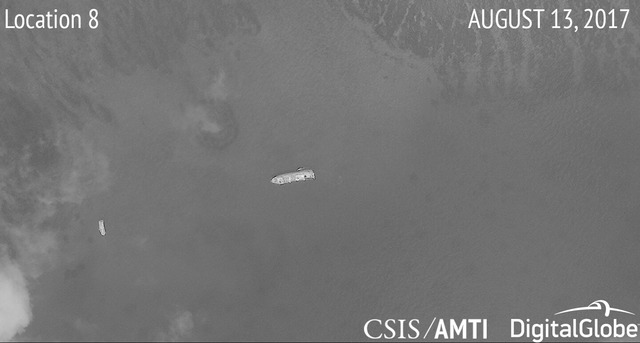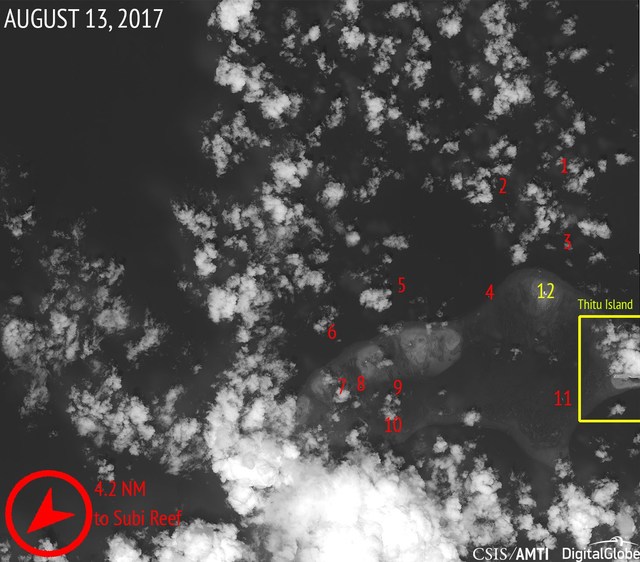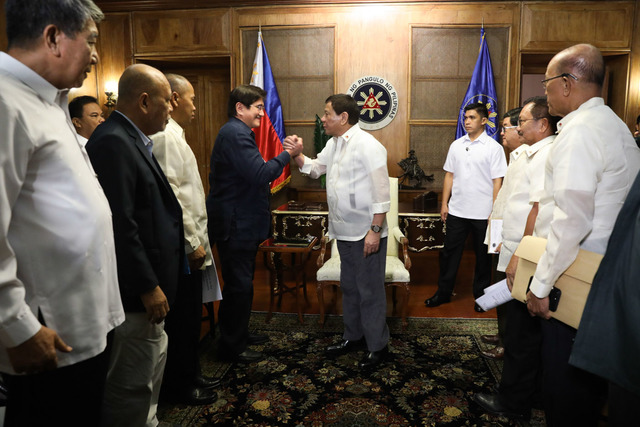Last June we posted a blog entry discussing the initial delivery of Chinese security assistance grant provided to the Philippine government, which was agreed upon during one of the meetings between the Chinese and Philippine leaders.
Based on previous press releases by the Philippine government, the Chinese security grant is worth around US$14.4 million and is said to be composed of sniper rifles, fast boats and rocket propelled grenades, although there were also previous statements including drones, force protection equipment, and other items into the expected aid.

While we do not have any photo of the actual patrol craft model for delivery from China, MaxDefense expects it to be somehow similar in size to the one on top, which is a different high speed boat made in China for law enforcement agencies. This particular boat model was actually among those offered to the Bureau of Customs for their own patrol craft requirement.
Photo taken from Datang Holdings product brochure.
Recap - First Tranche Aid Delivery:
This has been discussed in our earlier MaxDefense blog, which can be accessed here:
"Armed Forces of the Philippines Receives First Shipment of Defense Aid from China" - dated June 30, 2017.
Based on official statements from the government, China delivered the first tranche of the security aid last June, composed of 3,000 Norinco CQ-A5 5.56 x 45mm semi-automatic carbines, and 90 sniper rifles shared between the Norinco Type 85 "Dragunov" 7.62 x 54R marksman rifles, and the Norinco CS/LR4A 7.62 x 51mm sniper rifles, plus assorted ammunition composed of 5,000,000 rounds of 5.56 x 45mm rifle rounds, 800,000 7.62mm sniper rifle rounds. These were brought in to Clark Air Base last June 28, 2017 through four Ilyushin Il-76 strategic airlift aircraft of the People's Liberation Army Air Force.
MaxDefense's own analysis put the sniper rifles at 60 Type 85s and 30 CS/LR4As, based on photos available on the turn-over ceremony. The CS/LR4A came in hard plastic containers and includes a sighting scope
According to sources, the total worth of this tranche is around US$7 million, which means the Philippines is expecting another US$7 million worth of deliveries. Most of the CQ-A5 carbines and Type 85 Dragunov marksman rifles were turned over by the DND to the Philippine National Police, while some will be used for testing and study, probably by the Government Arsenal. Only the CS/LR4A sniper rifles appear to remain with the AFP, with some photos already coming out of the rifle being used by the Philippine Army in Marawi City.
This is not the first time China provided aid to Philippine security forces, with China actually donating several construction equipment to the AFP during Pres. Arroyo's term, which were used mostly by the Philippine Army's Engineering Brigades.

Pres. Duterte himself was present during the formal hand-over of the 1st tranche of Chinese defense assistance to the Philippines last June 28, 2017 at Clark Air Base.
Credits to owner of photo.
Second Tranche - What's Expected:
New statements from the government mentioned that the second tranche of deliveries will be coming in soon, estimated to be sometime between August and November 2017. But it is unclear which items are included, or if there will be a third tranche of deliveries.
Based on AFP Modernization Program update documents that MaxDefense was able to obtain, the 3,000 Norinco CQ-A5 carbines are actually part of an Urgent Military Assistance Gratis, and the inclusion of the ammunition and sniper rifles were just made later on instead of delivering them separately.
Also, it confirmed MaxDefense's earlier analysis on the quantity of sniper rifles. The delivery was indeed for 60 Norinco Type 85 "Dragunov" marksman rifles and 30 CS/LR4A sniper rifles.
The distribution of ammunition was also confirmed. The AFP did receive 20,000 rounds of Type CS BFL3A 7.62 x 51 ammunition for the CS/LR4A sniper rifles, and 800,000 rounds of 7.62 x 54R munitions for the Dragunovs. Take note that these Dragunov marksman rifles uses a different ammunition round compared to what the AFP and PNP are using.
Also on the same document, the Philippines is also scheduled to receive the following items on the next tranche of deliveries:
* 4 units of Type 966Y Patrol Craft with 7.62mm Multi-purpose Machine Guns
* 200 units of Norinco Type 69 Rocket Propelled Grenade Launchers
* 2,000 rounds of 40mm High Explosive Anti-Tank for the Type 69 RPGs
* 3,000 rounds of 40mm High Explosive Incendiary for the Type 69 RPGs
* 60 units of CS/ON6 Low-Light Sights for the Type 85 Dragunov marksman rifles
* 30 units of CS/ON8A Low-Light Sights for the CS/LR4A sniper rifles
Surprisingly, the CS/LR4A sniper rifles delivered last June 2017 included what appears to be a 4x sniper scope, while the Dragunovs appear to not have their scopes. So the deliver of additional sights for the CS/LR4A rifles is unusual, although the sights for the Dragunovs is highly expected.

Among the rifles delivered by China in its first tranche of security aid to the Philippines. Shown are the CS/LR4A sniper rifle, the CQ-A5 carbine, and two Type 85 marksman rifles. Credits to owner of photo.
Type 966Y Patrol Craft:
So far MaxDefense has been unsuccessful in getting information on this type of patrol boat, but it is expected that the would probably be an inshore patrol craft, probably less than 15 meters long, with high speed exceeding 40 knots, and is armed with a single 7.62mm machine gun. It is highly possible that the design of the boat is similar to those used by the China Coast Guard or the People's Armed Police units.
MaxDefense anticipates that the boat will be turned over to the Philippine Navy, but might be transferred later on either to the Philippine National Police - Special Boat Unit (Maritime Police), or to the Philippine Coast Guard, which are in need of additional assets.
It also remains to be seen what type of 7.62mm machine gun will be included in the delivery, considering that most Chinese machine guns of this caliber uses the same ammo as the Dragunovs, which is the 7.62 x 54R rimmed cartridge.
Based on our sourced documents, the patrol crafts are expected to be delivered by March 2018 although these Chinese could deliver them earlier if they deemed possible.
Type 69 RPG:
This is China's copy of the RPG-7 of the Soviet Union, and is also made by Norinco. It was first introduced in the 1970s, it is surprisingly still in production, probably for the export market, as China has moved on to newer models to replace the Type 69.
The Philippine Army won't have much problem in receiving these RPGs since it is close to the Bulgarian-made ATGLs that they are using, although it still remains to be seen if parts of the Type 69 and ATGLs are the same which will ease logistics and maintenance issues.
The ammunition for delivery are almost the same as to those already in use with the Philippine Army's ATGLs. MaxDefense sources confirmed that the Army has already expended thousands of RPG rounds in Marawi City alone, and the arrival of additional ammunition is a welcome addition as the emergency procurement of several thousands of RPG rounds remain hanging until now.
Based on our sourced documents, the Type 69 RPG as well as the ammunition are expected to be delivered on or before December 2017. Considering that there were already announcements of an impending delivery this August, it is expected that these will be among them, together with the low light sniper rifle sights which are intended for delivery by August 2017.

The Norinco Type 69 Rocket Propelled Grenade, which is a Chinese copy of the Soviet RPG-7.
Photo taken from SinoDefence.com
Where are the Others?
With the list above, some may ask, where are the force protection equipment, sniper rifles, and drones that were among those proposed earlier.
It appears that the focus was made on the delivery of 3,000 CQ-A5 carbines, which MaxDefense believes was not actually part of the original proposal. But this was inserted to fulfill requirements for the Philippine National Police, considering that none of the AFP's service branches requested for rifles, and it is not logical to have another rifle type considering the widespread use of the Remington R4A3.
Also, the 5,000,000 rounds of 5.56 x 45mm munitions for the CQ-A5 carbines were originally not part of the request either. MaxDefense believes that the ammunition alone may have used up to Php160 million of the fund, while the CQ-A5 carbines were reported to be worth Php210 million.
So MaxDefense believes that the funds intended for more sniper rifles, force protection equipment, and small drones may have been taken for the delivery of the carbines and its ammunition instead.
It remains to be seen if the Philippine government will further request assistance from China. Honestly speaking, MaxDefense believes it would be better if the Philippines will request aid int eh form of construction equipment from China for use by the military instead of weapons.
MaxDefense also believes that its best for the Philippines NOT to pursue the use of the US$500 million loan offer from China, considering that many in the AFP still prefer to source their weapons from other countries instead of China. Also, Chinese loans are very notorious for having very high interests as seen in the loans provided by China to several other countries.
MaxDefense will be monitoring the delivery of these Chinese aid, considering that the earliest arrival might be within this month.
http://maxdefense.blogspot.com/2017/08/upcoming-tranche-of-security-aid-from.html







